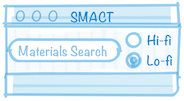Introduction to Chemeleon#
In the previous section, we explored structure prediction using SMACT’s statistical approach based on ionic substitutions. This method works well for finding variations of existing materials but is fundamentally limited to incremental changes based on known structures.
Chemeleon represents a shift in crystal structure exploration. Rather than starting with existing structures and making substitutions, Chemeleon uses generative artificial intelligence to create entirely new crystal structures from scratch, guided only by text descriptions.
The Difference#
While SMACT asks “What known structure could this composition adopt?”, Chemeleon asks “What entirely new structure could exist for this composition?”
Traditional Methods (like SMACT):
Start with a database of known structures
Apply substitution rules based on ionic similarities
Predict variations of existing materials
Conservative but reliable
Chemeleon’s Generative Approach:
Starts with pure noise (random atomic arrangements)
Uses AI to gradually refine this into a coherent crystal structure
Guided by text descriptions like “LiMnO4 with orthorhombic symmetry”
Can discover genuinely novel structural motifs
This means Chemeleon can:
Generate crystal structures from simple text descriptions
Explore vast regions of chemical space not accessible through substitution-based methods
Create both compositionally novel structures and new polymorphs of known materials
Propose structures that no human chemist has ever imagined
Park, H., Onwuli, A., & Walsh, A. (2025). Exploration of crystal chemical space using text-guided generative artificial intelligence. Nature Communications, 16(1), 1-14. doi:10.1038/s41467-025-59636-y
From Substitution to Generation: A Fundamental Shift#
To understand Chemeleon’s generatrive approach, let’s compare it directly with traditional methods:
Traditional Structure Prediction (SMACT Approach):#
Input: Chemical composition + existing structure database
Process: Find similar compositions → Apply substitution rules → Rank by probability
Output: Variations of known structures
Strengths: Reliable, chemically sensible, fast
Limitations: Cannot discover truly novel structural motifs
Generative Structure Prediction (Chemeleon Approach):#
Input: Text description (e.g., “TiO2 with high symmetry”)
Process: Start with noise → Gradually denoise using AI → Generate coherent structure
Output: Potentially novel crystal structures
Strengths: Unlimited creativity, can discover new motifs, explores vast chemical space
Limitations: Requires validation, may generate unstable structures
This shift from substitution to generation opens up entirely new possibilities for materials discovery, moving from incremental improvements to revolutionary breakthroughs.
How Chemeleon Works#
Chemeleon combines two powerful AI technologies:
1. Cross-Modal Learning (Crystal CLIP)#
Just as CLIP learns to connect images with text, Crystal CLIP learns to connect crystal structures with their descriptions. This allows the model to understand that “rutile TiO2” refers to a specific arrangement of titanium and oxygen atoms.
2. Diffusion Models#
Similar to how image generation models like DALL-E work, Chemeleon uses diffusion to generate crystal structures:
Starting from random noise
Gradually denoising to reveal a coherent crystal structure
Guided by the text embedding from Crystal CLIP
The model generates three components separately:
Atom types: Which elements are present
Lattice parameters: The size and shape of the unit cell
Atomic coordinates: Where each atom sits in the cell
Practical Applications#
Chemeleon has been successfully applied to:
Well-Studied Systems#
In the Ti-Zn-O system, Chemeleon:
Rediscovered known structures like TiO2 and ZnO (validating the approach)
Predicted new metastable phases not found in databases
Generated complete phase diagrams from text descriptions alone
Underexplored Systems#
For the Li-P-S-Cl system (important for solid-state batteries), Chemeleon:
Generated hundreds of candidate structures in minutes
Identified dynamically stable configurations through DFT validation
Explored quaternary chemical space that would take years to study experimentally
Polymorphism Discovery#
For TiO2 alone, Chemeleon:
Rediscovered all known polymorphs (rutile, anatase, brookite)
Proposed genuinely novel structural arrangements
Mapped the complete structural landscape of a single composition
This demonstrates Chemeleon’s ability to both validate known chemistry and discover new possibilities.
Advantages Over Traditional Methods#
Speed: Generate thousands of structures in minutes
Flexibility: No need for template structures
Creativity: Can propose genuinely novel arrangements
Accessibility: Simple text prompts instead of complex parameters
Current Limitations and Considerations#
Whilst Chemeleon is powerful, it’s important to understand its limitations:
Technical Limitations:#
Stoichiometry matching: Getting exact compositions can be challenging
Complex constraints: Difficult to specify precise numerical requirements in text
Training bias: Limited by the diversity of structures in the training dataset
Validation Requirements:#
Thermodynamic stability: Generated structures must be verified using DFT calculations
Dynamic stability: Phonon calculations needed to check if structures are stable
Synthetic accessibility: Not all stable structures can actually be made experimentally
When to Use Each Method:#
Use SMACT when: You want reliable variations of known materials, need fast screening, require high confidence
Use Chemeleon when: You want to explore novel structures, study underexplored chemical space, find new polymorphs
The best approach often combines both methods: use Chemeleon for exploration and SMACT for validation against known chemical patterns.
The Future of AI-Driven Materials Discovery#
Chemeleon represents just the beginning of AI-driven materials discovery. Future developments will enable:
True Inverse Design:#
Describe desired properties: “A material with high ionic conductivity and wide bandgap”
AI generates structures predicted to have those properties
Move from composition-based to property-based design
Multi-modal AI:#
Combine text descriptions with property constraints
Integrate experimental synthesis conditions
Account for thermodynamic and kinetic factors
Autonomous Discovery:#
AI systems that can propose, generate, validate, and even synthesise new materials
Closed-loop discovery where AI learns from each experiment
Acceleration of materials development from decades to years
In the next section, we’ll explore how to use Chemeleon for your own materials discovery projects, including both Crystal Structure Prediction (CSP) and De Novo Generation (DNG) tasks.
